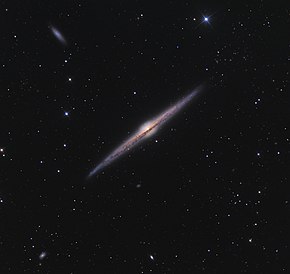NGC 4565
| NGC 4565 | |
|---|---|
 NGC 4565 | |
| Observation data (J2000 epoch) | |
| Constellation | Coma Berenices |
| Right ascension | 12h 36m 20.8s[1] |
| Declination | +25° 59′ 16″[1] |
| Redshift | 0.004103[1] |
| Heliocentric radial velocity | 1230 ± 5 km/s[1] |
| Distance | 42.7 ± 12 Mly (13.1 ± 3.7 Mpc)[2] 53 ± 4 Mly (16.2 ± 1.3 Mpc)[3] |
| Apparent magnitude (V) | 10.42[1] |
| Characteristics | |
| Type | SA(s)b?[1] |
| Apparent size (V) | 15.90′ × 1.85′[1] |
| Other designations | |
| UGC 7772,[1] PGC 42038,[1] Caldwell 38 | |
NGC 4565 (also known as the Needle Galaxy or Caldwell 38) is an edge-on spiral galaxy about 30 to 50 million light-years away in the constellation Coma Berenices.[2] It lies close to the North Galactic Pole and has a visual magnitude of approximately 10. It is known as the Needle Galaxy for its narrow profile.[4] First recorded in 1785 by William Herschel, it is a prominent example of an edge-on spiral galaxy.[5]
Characteristics
[edit]NGC 4565 is a giant spiral galaxy more luminous than the Andromeda Galaxy.[6] Much speculation exists in literature as to the nature of the central bulge. In the absence of clear-cut dynamical data on the motions of stars in the bulge, the photometric data alone cannot adjudge among various options put forth. However, its exponential shape suggested that it is a barred spiral galaxy.[7] Studies with the help of the Spitzer Space Telescope not only confirmed the presence of a central bar but also showed a pseudobulge within it as well as an inner ring.[8]
NGC 4565 has at least two satellite galaxies, one of which is interacting with it.[9] It has a population of roughly 240 globular clusters, more than the Milky Way.[6]
NGC 4565 is one of the brightest[10] member galaxies of the Coma I Group.[11][10]
This edge-on galaxy exhibits a slightly warped and extended disk under deep optical surveys, likely due to ongoing interactions with neighboring satellite galaxies or other galaxies in the Coma I group. GALEX images show the slight warp at the edge of the disc more clearly than other surveys.
Using the LOw-Frequency ARray (LOFAR), astronomers of the University of Hamburg discovered a diffuse radio halo around NGC 4565. During the observations, a warp was detected in the radio continuum of NGC 4565 that is reminiscent of a neutral hydrogen line (HI) warp and identifying a slight flaring of the galaxy's radio halo. It is assumed that this flaring is caused by the warp as the vertical intensity profiles are asymmetric, which is in agreement with the warp. According to the study, a minimum age for the warp was estimated at approximately 130 million years. This is the spectral age of the galaxy's cosmic ray electrons, during which they are transported into the warp. This indicates that NGC 4565 may be in the aftermath of a period with more intense star formation.

References
[edit]- ^ a b c d e f g h i "Results for NGC 4565". NASA/IPAC Extragalactic Database. Retrieved 2006-10-12.
- ^ a b "Distance Results for NGC 4565". NASA/IPAC Extragalactic Database. Retrieved 2010-05-02.
- ^ Jensen, Joseph B.; Tonry, John L.; Barris, Brian J.; Thompson, Rodger I.; et al. (February 2003). "Measuring Distances and Probing the Unresolved Stellar Populations of Galaxies Using Infrared Surface Brightness Fluctuations". Astrophysical Journal. 583 (2): 712–726. arXiv:astro-ph/0210129. Bibcode:2003ApJ...583..712J. doi:10.1086/345430. S2CID 551714.
- ^ "NGC4565 at". apod.nasa.gov.
- ^ Spiral Galaxy NGC 4565 at http://www.eso.org/public/images/eso0525a/
- ^ a b Globular Cluster Systems in Galaxies Beyond the Local Group
- ^ Wu, Hong; et al. (2002). "Intermediate-band surface photometry of the edge-on galaxy NGC 4565". The Astronomical Journal. 123 (3): 1364–1380. arXiv:astro-ph/0111433. Bibcode:2002AJ....123.1364W. doi:10.1086/338849.
- ^ Detection of a Distinct Pseudobulge Hidden Inside the Box-Shaped Bulge of NGC 4565
- ^ HALOGAS: H I Observations and Modeling of the Nearby Edge-on Spiral Galaxy NGC 4565
- ^ a b "Webb Deep-Sky Society: Galaxy of the Month: NGC4565". www.webbdeepsky.com. Retrieved 2018-05-20.
- ^ Gregory, Stephen A.; Thompson, Laird A. (April 1977). "The Coma i Galaxy Cloud". The Astrophysical Journal. 213: 345–350. Bibcode:1977ApJ...213..345G. doi:10.1086/155160. ISSN 0004-637X.
External links
[edit] Media related to NGC 4565 at Wikimedia Commons
Media related to NGC 4565 at Wikimedia Commons- NGC 4565 on WikiSky: DSS2, SDSS, GALEX, IRAS, Hydrogen α, X-Ray, Astrophoto, Sky Map, Articles and images
- National Optical Astronomical Observatory Archived 2009-05-22 at the Wayback Machine – NGC 4565
- APOD (2024-06-06) - NGC 4565: Galaxy on Edge
- APOD (2010-03-04) – NGC 4565: Galaxy on Edge
- APOD (2009-04-28) – NGC 4565
- SEDS – NGC 4565
